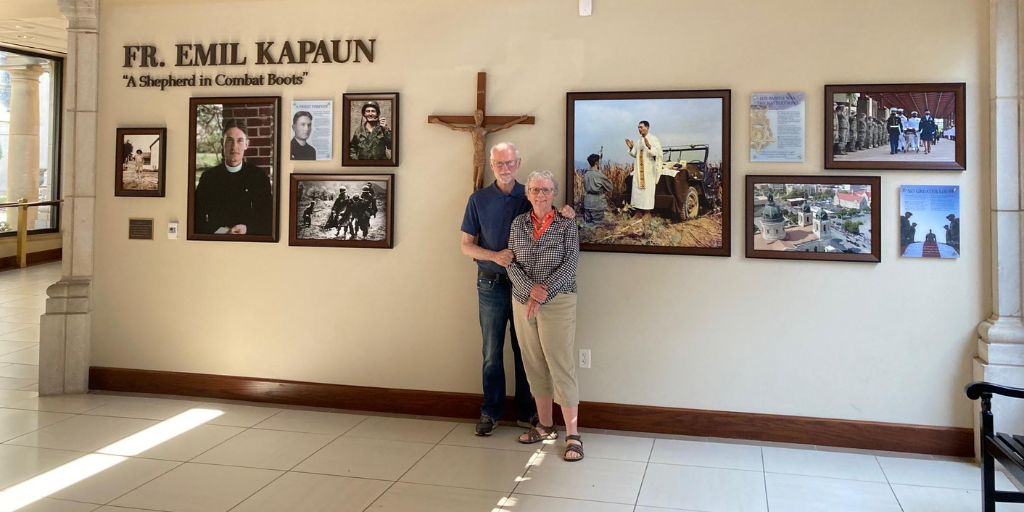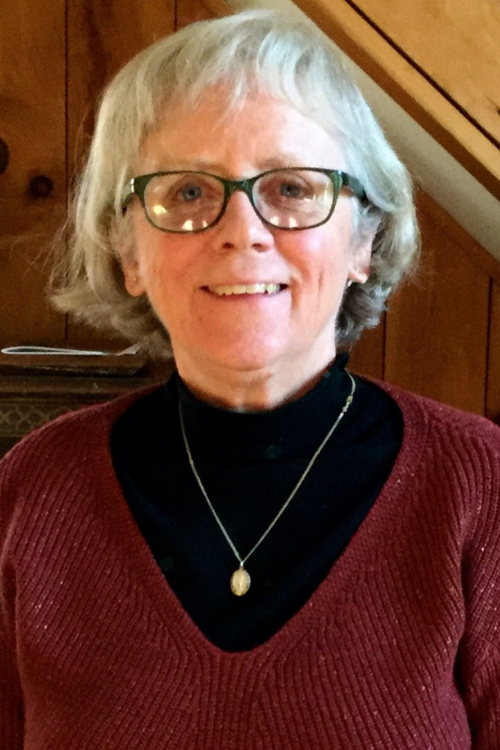
Kathryn Swegart recounts her recent visit to the tomb of Servant of God Emil Kapaun, a heroic Korean War chaplain who died as a prisoner of war.
This summer my husband and I flew out to the Midwest for a visit to family in Oklahoma and Kansas. Never had this New Englander laid eyes on wheatfields that stretched far as the eye could see. In Oklahoma, I revealed my roots when I asked my husband, “Is that a cell phone tower or an oil derrick?” It was an easy three-hour drive from Tulsa to Wichita, past Mennonite communities and giant wind turbines.
I was eager to visit with family. I was also excited at the prospect of visiting the tomb of Servant of God Emil Kapaun, heroic Army chaplain during the Korean War. He is entombed at the Cathedral of the Immaculate Conception in Wichita. Kneeling at his tomb had a startling effect on me.

A saintly priest
Father Kapaun was born in the kitchen of the family farm on April 20, 1916. Pilsen, Kansas was a prairie community that served mostly settlers of Bohemian extraction. Raised in the school of hard work, Emil spent long hours in the garden, pulling weeds and harvesting crops under the scorching sun. He enjoyed hunting, fishing, and swimming. Beyond these endeavors, Emil was a dedicated altar boy who often rode his bike three miles to the church.
As the young farm boy grew, an inner voice spoke to him. He was called to the priesthood, culminating in his ordination on June 9, 1940. The young priest served the people of his home parish, but soon felt a call to become an Army chaplain, first toward the end of World War II and later in the Korean War. Father Kapaun’s regiment was one of the first sent by the United States to assist South Korea in the fight against communist North Korea. By July 1950, Father Kapaun witnessed the horrors of war. Bodies of the dead lay strewn on battlegrounds. Tortuous heat, swarms of mosquitos, sleepless nights, and hunger plagued the troops.
Through all this torment, Father Kapaun calmly risked his life to rescued wounded soldiers, administered Last Rites to the dying, and said Mass, using a jeep for his altar. News spread throughout the troops that the war was soon to end, that the North Koreans were in retreat.
A priest faces the horrors of war
That all changed on November 1, 1950, when thousands of Chinese troops entered the battle, overwhelming U.S. forces and capturing Father Kapaun and the men of his battalion. Thus began a 60-mile death march to POW Camp 5 on the Chinese border. Men afflicted with frostbite and war wounds fell in the frozen mud. Chinese soldiers would either shoot the fallen or leave them for dead.
That was to be the fate of Sergeant Henry Miller, who fell to the ground. An enemy soldier took aim with his rifle. Suddenly, Father Kapaun ran over, calmly pushed the rifle away and picked up Miller. They walked arm in arm to Camp 5. The Chinese soldier was so shocked, that he did not shoot the men.
Father Kapaun once wrote about his priesthood:
When I was ordained, I was determined to "spend myself" for God. I was determined to do that cheerfully, no matter in what circumstances or how hard a life I would be asked to lead. (quoted in A Shepherd in Combat Boots by William L. Maher)
At the time he wrote those words, he likely could not have imagined the horror of war that awaited him.
In the prison camp, Kapaun was the first one to arise. He would gather sticks and start fires to melt snow for clean water. He laundered clothes for his fellow prisoners and sneaked out of camp to salvage corn, salt, millet, and soybeans. Upon the death of fellow prisoners, the good priest volunteered for burial duty and prayed over his fallen comrades.
On Easter Sunday 1951, Father Kapaun led an Easter service, reminding the emaciated prisoners of Christ’s suffering and the hope of His Resurrection. Several weeks later, he fell ill with pneumonia and was sent by his captors to the “death house” where he died alone. His remains were unidentified for 70 years. Miraculously, his remains were identified, and he received a hero’s welcome to Wichita in 2021.

The Communion of Saints in action
Now I take you back to my pilgrimage to the Wichita cathedral for Sunday Mass. To my surprise, the tomb of Father Kapaun lay in full view at the magnificent cathedral. I knelt by the tomb and prayed fervently for a special intention. Tears welled up in my eyes and my heart pounded. I had a sense that the spirit of Father Kapaun was close, comforting me. Here indeed was the Communion of Saints in action.
Share your thoughts with the Catholic Mom community! You'll find the comment box below the author's bio and list of recommended articles.
Copyright 2024 Kathryn Swegart
Images: copyright 2024 Kathryn Swegart, all rights reserved.
About the Author

Kathryn Swegart
Kathryn Griffin Swegart is an award-winning author of Catholic books for children. Kathryn and her husband raised three children on a small farm in rural Maine. She is a professed member of the Secular Franciscan Order and contributor to Magnificat. Visit her website at KathrynSwegart.com.


.png?width=1806&height=731&name=CatholicMom_hcfm_logo1_pos_871c_2728c%20(002).png)
Comments